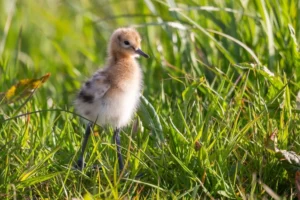The black tailed godwit has one of the longest known non-stop migration routes of any bird.
This medium-sized wading bird undertakes an epic journey twice a year between breeding grounds in Iceland, Scandinavia, and Western Europe and wintering spots in Western Africa.
Black-tailed godwits use their distinctive long beaks, black and white plumage, and spindly legs,
Black-tailed godwits are a spectacle both in flight and as they forage for food in wetlands and estuaries.
Let’s explore the fascinating life of these long-distance champions.
Let’s dive into our topic!
WHAT IS THE LONGEST FLIGHT BY BLACK TAILED GODWIT?
It is not the only bird that records the longest flight, but the swift bird can remain in the air for nearly 10 months ahead.
So, it’s clear that the black-tailed godwit is not the fastest bird in the bird.
But, the black-tailed godwit had got the Non-stop 8000-kilometre journey which is fascinating.
A NON-STOP 8,000-KILOMETER JOURNEY

Black tailed godwits depart their breeding grounds for the epic flight to sub-Saharan Africa in late August through September.
One population makes an astonishing non-stop journey of over 8,000 kilometres in just 6 days from Iceland to stopover sites in Portugal and West Africa.
WHAT IS SPECIAL ABOUT THE GODWIT?
Godwit is very famous because of its longest flight.
You can’t believe this, but it’s the most comprehensive route for any bird whether birds fly at night to cover in that much time.
Black tailed godwits have covered this long distance with a speed of nearly 55 km per hour.
Which can clearly say how fascinating this bird is!
HOW DO THESE MEDIUM-SIZED BIRDS ACHIEVE SUCH A MARATHON FLIGHT?

They cram on food for weeks before building up fat reserves.
Their digestive systems also shrink to reduce weight, allowing more space for fat storage.
In flight, godwits glide and flap using uplift to minimize the time, and energy spent flapping.
They can sleep with one half of their brain at a time while gliding. Powered by fat, godwits only stop briefly to feed before continuing.
For their immense effort, godwits gain safety in numbers and abundant food in West Africa, where they overwinter.
WINTERING AND EATING WELL IN AFRICA
Most black tailed godwits overwinter in coastal West Africa, especially in areas like Mauritania’s Banc d’Arguin National Park.
Here they feed voraciously on crustaceans, worms, molluscs, and other invertebrates brought in by the tide.
Their primary diet comprises insects such as many other birds that eat cicadas.
With little seasonal change near the equator, godwits spend their winter resting, feeding, and recovering from their long flight.
In February and March, the godwits begin their journey north again.
The same individuals breed in the exact locations year after year, showing an incredible homing ability and site fidelity.
Once back on the breeding grounds, the godwits pair up again, and the cycle of nesting and raising another generation of chicks begins anew.
BREEDING AND NESTING IN THE SHORT SUMMER

As soon as the wintering season ends in Africa, black-tailed godwits go north to breed in temperate regions of Iceland, Scandinavia, Northern Europe, and the British Isles.
The females, known as hens, nest on the ground in a shallow depression, lining it with leaves and grass to lay usually four eggs some others also lay light blue eggs.
For the next 4 weeks, the hens incubate the eggs while the males, or cocks, stand guard.
When the chicks hatch, both parents feed the demanding babies.
As the chicks grow, the parents lead them to areas rich in worms, crustaceans, and other invertebrates.
After about a month, the chicks fledge and learn to feed themselves.
By late summer, the godwits gather in large flocks in preparation for their migration south.
WHAT IS THE THREAT TO BAR-TAILED GODWIT?
The black tailed godwit is a champion migrant and inspirational species showing extreme endurance and navigation ability.
Yet, like many migratory birds, their populations have rapidly declined over the past few decades because of habitat loss and changes along their migration routes and wintering sites.
Agricultural changes have reduced available breeding habitats, and coastal developments threaten estuaries and wetlands where godwits feed and rest.
However, conservation efforts are underway to protect critical areas for godwits like the Banc d’Arguin National Park.
Ecotourism focusing on migratory birds can also motivate local communities to protect habitats.
Satellite tracking of individuals has also revealed the key sites godwits rely on, pinpointing where support for protection is most needed.
By safeguarding habitats, raising awareness, and reducing threats along this epic migratory route, the fascinating black-tailed godwit can continue their inspiring long-haul journeys for generations.
CONCLUSION
The black tailed godwit is the bird that covers the longest distance of 8000 kilometres.
This is the most remarkable thing and the reason why it is famous.
The mostly diet of this bird consists of insects such as mealworms, cicadas, etc.
We hope you love reading this! Let we know what you think about this marvellous bird in the comment section.
[su_box title=”Suggested” style=”noise” title_color=”#fec201″]here are some of our other masterpieces[/su_box]
